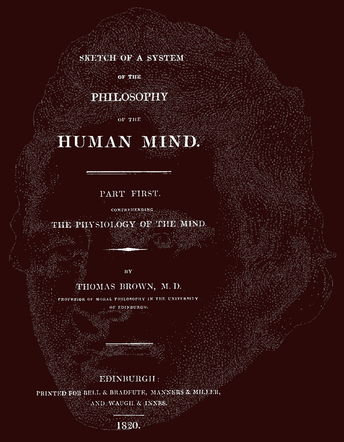Thomas Brown1778–1820
Thomas Reid is considered to be the founder of the Scottish common-sense school of philosophy and he was followed by Dugald Stewart (1753-1828), Thomas Brown, and William Hamilton (1788-1856), all of whom taught at Edinburgh University. In formalizing this ‘common sense school’ they were opposed to associationism, particularly when it was couched in physiological language. More specifically, they were critical of the attempts by Hartley to unite the physical and psychological worlds by means of a speculative neurophysiology. Reid was an advocate of the Newtonian method of ‘observation and experiment’ but he did not think that these could be applied by the ‘anatomist of the mind’. The position of the common-sense school was suitably summarized by Stewart: “The Physiological Theories which profess to explain how our different mental operations are produced by means of vibrations, and other changes in the state of the sensorium, if they are not altogether hypothetical and visionary, cannot be considered, even by their warmest advocates, as resting on the same evidence with those conclusions which are open to the examination of all men capable of exercising the power of Reflection”. Stewart’s philosophy of mind became Brown’s physiology of mind. Brown was trained in medicine as well as philosophy, but the former did not often intrude into his musings on mind. He was much more astute when writing about the senses, and argued persuasively for a separate muscle sense: “To what organ, then, are we to ascribe the external influences, which give occasion to these feelings of resistance and extension? It is not touch, as I conceive, that either of these be traced. Our feeling of resistance, in all its varieties of hardness, softness, roughness, smoothness, solidity, liquidity, &c. I consider as the result of organic affections, not tactual, but muscular; our muscular frame being truly an organ of sense, that is affected in various ways, by various modifications of external resistance to the effort of contraction”. It was in the same theatre of the senses that Hamilton advanced understanding of the muscle sense, although he had a more thorough knowledge of the earlier German literature than Brown. The term “Muskelsinn” had been used by German writers in the eighteenth century, and it was suggested that the idea was described even earlier. More precise evidence of a movement sense was to derive from an Edinburgh chemist working in the medical tradition – Alexander Crum Brown. This was also the area in which Thomas Brown crossed swords with Erasmus Darwin. Darwin’s Zoonomia excited great interest when it was published in 1794 and 1796, not least in Brown. His marginal notes and trenchant criticisms resulted in a tome of almost 600 pages in which Darwin’s structure was dissected chapter by chapter. Initially Brown, an eighteen-year-old student at Edinburgh University, wrote to Darwin praising the book and promising a lengthier appraisal. Darwin appreciated the praise but was disparaging about the appraisal, so much so that Brown’s biographer forbore to reprint Darwin’s response. Following more congenial correspondence, Brown committed his thoughts to print. Brown attacked Darwin’s theory of vertigo (based on afterimages) by drawing attention to its inconsistencies. Brown observed that the objects that appeared to move following body rotation were those that were in front of the eyes, not those that had been passed during rotation. In order to produce a clear afterimage Brown rotated his body while looking at a book held in front of him; when rotation ceased he did not experience any afterimage of the book. When he rotated his body with his eyes open and then stepped into a darkened room he did not experience any visual vertigo. On the other hand, when he rotated in one room (with his eyes open) and then stepped into another lighted room, it was the objects in the latter that appeared to rotate. Finally, he bandaged his eyes during body rotation and removed the cover after rotation ceased, only to experience visual motion once more. Brown is shown in the title page of his book on the physiology of mind.
